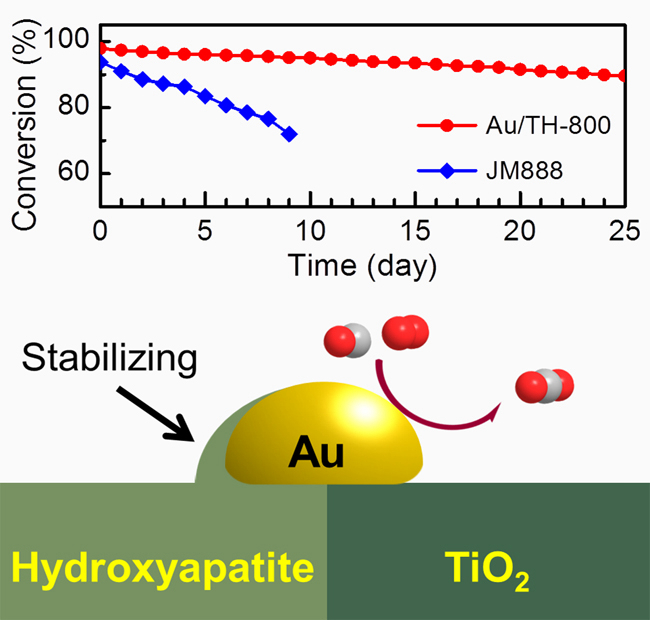
Researchers from Dalian Institute of Chemical Physics (DICP) of Chinese Academy of Sciences have successfully synthesized an ultrastable and highly active Au nanocatalyst (Au/TiO2-HAP) by tuning the Strong Metal-Support Interaction (SMSI) between Au and hydroxyapatite (HAP). This catalyst demonstrated excellent durability that outperforms a commercial Three Way Catalyst (TWC) JM888 for CO oxidation under simulated practical conditions.
During the past decades, supported Au nanocatalysts have attracted intensive interest because of their unique catalytic properties. Their poor thermal stability, however, presents a major barrier to the practical applications. Therefore, to fabricate ultrastable Au nanocatalysts with high activity for practical applications still remains a formidable challenge.
Researchers discovered that Au nanoparticles (NPs) could form SMSI with HAP upon high-temperature calcination and result in the encapsulation of Au NPs which improves their sintering resistance significantly (J. Am. Chem. Soc. 2016, 138, 56-59). However, the full encapsulation reduces their activity due to the coverage of the active sites.
To resolve this problem, researchers manipulated the SMSI between Au and HAP (i.e., the degree of encapsulation) by incorporating TiO2 into the HAP support. It was found that this catalyst possessed high activity and good sintering resistance after calcination at 800 °C for a variety of reactions. It also demonstrated excellent durability that outperforms a commercial TWC for CO oxidation under simulated practical conditions.
Systematic studies show that the Au NPs primarily located at the interfaces between TiO2 and HAP makes the Au NPs partially covered by a thin layer of the HAP. The SMSI contributed to the excellent stability and anti-sintering property of the catalyst, and the partially exposed to TiO2 contributed to the high activity of the catalyst.
This work suggests the great potential of supported Au catalysts for practical applications. Besides, it provides a new strategy to develop ultrastable Au nanocatalysts with high activity by designing and tuning the SMSI.
This study was published in Angew. Chem. Int. Ed. Prof. Masatake Haruta, the pioneer in gold catalysis, highlighted this work with a short comment entitled as “Ultrastable nanogold catalyst—on the way going to practical application.”
This work was financially supported by the National Natural Science Foundation of China.

Figure: The Au NPs located at the TiO2/HAP interfaces (Imaged by TANG Hailian and QIAO Botao)

86-10-68597521 (day)
86-10-68597289 (night)

86-10-68511095 (day)
86-10-68512458 (night)

cas_en@cas.cn

52 Sanlihe Rd., Xicheng District,
Beijing, China (100864)

